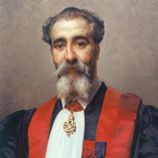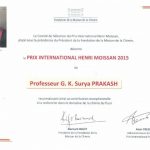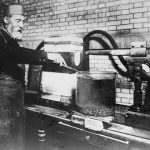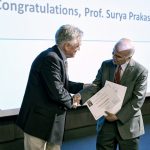Introduction

Le Prix international Henri Moissan fut créé à l’issue du Symposium de 1986 qui s’était tenu à Paris pour commémorer le centenaire de l’isolement du fluor par ce grand savant en juin 1886. La finalité de ce Prix, telle qu’initialement désirée par les deux co-présidents du Symposium, Paul Hagenmuller et Pierre Plurien, était de récompenser un chercheur de stature internationale ayant œuvré dans les domaines du fluor et des produits fluorés. Jusqu’en 2005, Roland Bougon s’est acquitté de la tâche d’administrateur du Prix avec l’aide d’un collège d’électeurs choisis parmi les spécialistes mondiaux du fluor. Durant cette période, le Prix fut décerné sept fois, à l’occasion des Symposiums Internationaux sur la Chimie du Fluor (ISFC) qui ont lieu tous les trois ans.
Depuis 2009, la Fondation de la Maison de la Chimie assume la gestion du Prix, de manière à donner une structure pérenne à cette récompense prestigieuse.
Le Prix consiste en la remise d’un diplôme, d’une médaille en bronze à l’effigie d’Henri Moissan et de la somme de 15 000 €.
*
The Prize was created after the Centennial 1986 Paris Symposium to commemorate Moissan’s isolation of elemental fluorine in 1886, and to stimulate research in the fields of fluorine chemistry. In twenty years, the prize was managed by the « Institution du Prix Moissan », founded by Paul Hagenmuller and Pierre Plurien, both Chairmen of the 1986 Symposium, with Roland Bougon as administrator. During this period, the Prize was attributed seven times, that is every three years at the opportunity of the International Symposia on Fluorine Chemistry (ISFC).
Since 2009 the Fondation de la Maison de la Chimie has taken in charge the management of the Prize, in order to give a perennial structure to this prestigious award.
The Prize, which is presented every three years during the International Symposium on Fluorine Chemistry (ISFC), carries a diploma and a monetary award of 15 000 €.
The previous awardees were:
- 1988: Neil Bartlett (University of California, Berkeley, USA)
- 1988: George Cady (University of Washington, Seattle, USA)
- 1991: Harry J. Emeléus (University of Cambridge, UK)
- 1994: Robert N. Haszeldine (UMIST, University of Manchester, UK)
- 1997: Paul Hagenmuller (University of Bordeaux I, France)
- 2000: Karl Christe (USC, Los Angeles and Edwards Air Force Base, California, USA)
- 2003: Richard Chambers (University of Durham, UK)
- 2006: Darryl D. DesMarteau (Clemson University, SC, USA)
- 2009: Herbert Roesky (Göttingen University, Germany)
- 2012: Alain Tressaud (ICMCB-CNRS, Bordeaux, France)
- 2015: G. K Surya Prakash (USC, USA)
- 2018: David O’Hagan (University of St Andrews, United Kingdom)
- 2021: Véronique Gouverneur (University of Oxford, United Kingdom)
Scientific Committee
President :
Philippe GŒBEL, Fondation de la Maison de la Chimie
Scientific Administrator :
Thierry BILLARD, CNRS, Lyon
Members :
- Bruno AMEDURI, CNRS, Montpellier
- Philippe BONNET, Arkema, Pierre Bénite
- Karl CHRISTE, USC, Los Angeles (USA) – Moissan Prize 2000
- Alain DEMOURGUES, CNRS, Bordeaux
- Darryl DesMARTEAU, Clemson University (USA) – Moissan Prize 2006
- Henri DUGERT, General Secretary, Fondation de la Maison de la Chimie
- Marie-Pierre KRAFT, CNRS, Strasbourg
- Frédéric LEROUX, CNRS, Strasbourg
- Vincent MAISONNEUVE, IMMM, Université du Mans
- David O’HAGAN, University of St Andrews (UK) – Moissan Prize 2018
- Surya PRAKASH, USC, Los Angeles (USA) – Moissan Prize 2015
- Herbert ROESKY, Göttingen (Germany), foreign Member of the French Academy of Sciences – Moissan Prize 2009
- Etienne SCHMITT, Syensqo, Soucieu-en-Jarrest
- Alain TRESSAUD, European Academy of Sciences, Brussels – Prix Moissan 2012
Election
Le lauréat est désigné par un collège composé d’une centaine d’éminents spécialistes du fluor (+ les membres du Comité Scientifique), bien représentatifs des divers domaines scientifiques ainsi que des pays dans lesquels la chimie du fluor est présente, dont la composition est revue avant chaque Prix. Ces électeurs ont été choisis par le Comité Scientifique du prix sous la présidence du Président de la Fondation de la Maison de la Chimie et votent à titre individuel.
L’élection se fait en deux temps : dans un premier, chaque électeur propose un maximum de cinq candidats. Les personnes qui sont sélectionnées pour le second tour sont celles qui ont obtenu le plus grand nombre de voix avec une marge significative par rapport aux suivants. Cette liste de noms : quatre en 2006, six en 2012, cinq en 2009 et 2015, trois en 2018 est envoyée au collège des électeurs qui, dans un second vote, choisissent un seul ou deux noms au maximum. Le vainqueur est celui qui a obtenu le plus grand nombre de suffrages, mais le Prix peut être partagé lorsqu’il y a égalité, comme ce fut le cas en 1988.
*
The Prize winner is elected by an International Selection Board of about one hundred personalities (+ Scientific Committee members) chosen by the Scientific Committee of the Prize. The composition of this international college is reconsidered before each Prize. The final choice of the Board members should be guided by both the prestige of each fluorine chemist proposed and the need to establish a balance with respect to nationality and scientific fields. The members of the Board are asked to vote as individuals.
In the first ballot of the election, each member of the Selection Committee proposes a maximum of five candidates. The Scientific Committee will select the nominees for the Prize, as those candidates who have received the highest number of votes with a significant gap with respect to the following ones. This list (four names in 2006, six in 2012, five in 2009 and 2015, three in 2018) is then sent to all members of the Selection Board for a second ballot, in which a maximum of two names is selected from this list. For the second round, voters should vote for one or two names maximum. It is obvious that those members who will be selected as nominees will not take part in the second ballot. The winner is the candidate who receives the largest number of suffrages, but the Prize may be shared if two candidates get an equal number of votes, as it was the case for the first Prize in 1988.
Nominations can be based on the candidate’s entire career work or a recent outstanding contribution to any field of fluorine chemistry.







